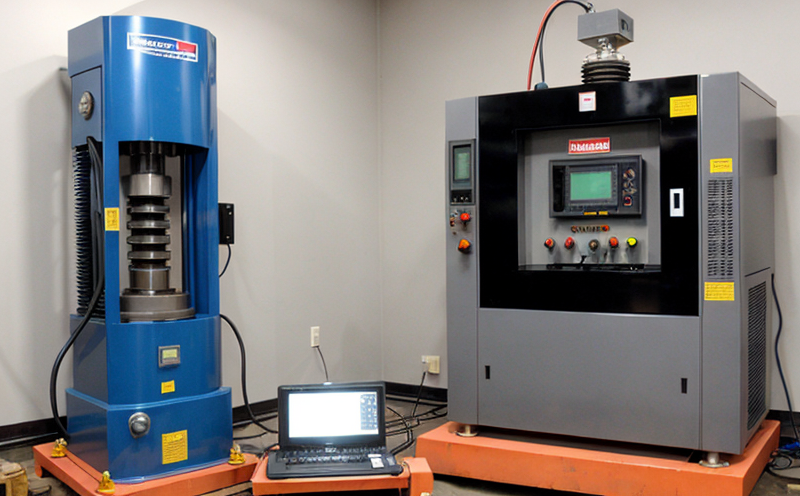Drop Shock Testing for Portable Devices
In today’s fast-paced world, portable devices such as smartphones, tablets, and wearables are integral to our daily lives. These products must withstand various environmental stresses, including mechanical shocks that they encounter in real-world use. Drop shock testing is a critical procedure used to evaluate the durability of these devices under sudden impacts. This test ensures that portable electronics can operate safely without damage or functional degradation when subjected to typical drop scenarios.
The purpose of this testing is to simulate the potential hazards faced by portable devices during transport, handling, and accidental falls. By subjecting the device to controlled drops from different heights on various surfaces, we can determine its resistance to mechanical shocks. The test helps manufacturers identify design flaws, material weaknesses, or manufacturing defects that could lead to premature failure.
The test setup involves placing the portable device in a test fixture designed to align it with the intended orientation for use. The device is then dropped from specified heights onto different surfaces such as concrete, steel plates, or rubber mats, depending on the test’s requirements and the type of environment the product might encounter. The choice of surface material affects how energy is absorbed during the impact, influencing the results.
Understanding the drop height is crucial for accurate testing. According to ISO 22476-1:2018, the standard governing drop shock tests for portable devices, specific heights are recommended based on the product’s size and intended usage. For instance, smaller devices may be tested from a lower height (e.g., 50 cm) while larger or more robust units might withstand higher impacts (up to 120 cm).
The test setup also includes monitoring parameters such as the angle of impact, surface type, and drop velocity. These factors are critical in ensuring that each test replicates real-world conditions accurately. The use of high-speed cameras or accelerometers can provide additional insights into how the device reacts to the impact.
After the drop, thorough inspections follow to check for any visible signs of damage such as cracks, dents, or changes in appearance. Additionally, functional tests are conducted to verify that the device still operates correctly after the shock. If the device passes both visual and functional checks, it is considered compliant with industry standards.
The results of drop shock testing are essential for quality managers and compliance officers who ensure products meet regulatory requirements. It also aids in R&D by providing data on how different materials or design changes affect a product’s durability. For procurement teams, this test ensures that the components used in manufacturing these devices can handle real-world stresses effectively.
Applied Standards
The DROP SHOCK TESTING FOR PORTABLE DEVICES service adheres to several international standards that ensure consistency and reliability across different testing environments. The primary standard used is ISO 22476-1:2018, which provides a comprehensive framework for conducting drop shock tests on portable electronic devices. This standard covers the test setup, procedure, and acceptance criteria.
In addition to ISO standards, other relevant documents include ASTM E337-95(2014) which focuses on drop tests of consumer products, and IEC 60068-2-27:2008 that covers environmental testing. These guidelines help ensure that the testing process is standardized and replicable.
The compliance with these standards ensures that the results from our lab are accepted globally, enhancing the credibility of your product development processes. Compliance officers can use this service to validate their products against international benchmarks, ensuring they meet regulatory requirements in multiple jurisdictions.
Why Choose This Test
- Ensures Product Safety: By simulating real-world drop conditions, we ensure that your portable devices are safe from potential hazards during transportation and usage.
- Promotes Durability: Identifies design flaws and material weaknesses early in the development process to enhance product longevity.
- Compliance Assurance: Ensures that products meet international standards like ISO 22476-1:2018, enhancing compliance with global regulatory requirements.
- R&D Insights: Provides valuable data for R&D teams to refine product designs and improve material choices.
- Customer Satisfaction: Builds trust by demonstrating a commitment to quality and safety in the products you offer your customers.
- Cost Efficiency: Identifies issues early, reducing the need for costly redesigns or recalls later in the development cycle.
The comprehensive nature of drop shock testing makes it an indispensable tool in any electronics manufacturer’s quality assurance arsenal. By incorporating this test into your product development process, you can ensure that your portable devices are robust and reliable, meeting both current standards and future challenges.
International Acceptance and Recognition
The results from DROP SHOCK TESTING FOR PORTABLE DEVICES are widely recognized across the global electronics industry. Our laboratory adheres strictly to international standards such as ISO 22476-1:2018, ASTM E337-95(2014), and IEC 60068-2-27:2008. These standards ensure that the testing process is consistent and replicable, leading to internationally accepted results.
Our compliance with these standards enhances your product’s credibility in international markets. Regulatory bodies in countries like Europe, North America, Asia, and Australia accept our test results as meeting their respective requirements. This acceptance simplifies the certification process for your products, reducing time-to-market and associated costs.
The recognition of our testing services extends beyond regulatory compliance. Leading brands trust us to provide reliable data that informs product design decisions. By leveraging this expertise, you can stay ahead in a competitive market by ensuring your products are robust and safe.





